Scoping for the Operation of Agile Urban Adaptation for Secondary Cities of the Global South: Possibilities in Pune, India
Abstract
:1. Introduction
2. Methodology
3. Case Study Application
4. Discussions
5. Conclusions
Acknowledgments
Author Contributions
Conflicts of Interest
References
- Revi, A.D.E.; Satterthwaite, F.; Aragón-Durand, J.; Corfee-Morlot, R.B.R.; Kiunsi, M.; Pelling, M.; Roberts, D.C.; Solecki, W. Urban Areas, in Climate Change 2014: Impacts, Adaptation, and Vulnerability. Part A: Global and Sectoral Aspects. Contribution of Working Group II to the Fifth Assessment Report of the Intergovernmental Panel of Climate Change; Balbus, J., Cardona, O.D., Eds.; Cambridge University Press: Cambridge, UK; New York, NY, USA, 2014; pp. 535–612. [Google Scholar]
- Burton, I. Climate Change and Adaptation Deficit. In Proceedings of the International Conference on Adaptation Science, Management and Policy Options, Lijiang, Yunnan, China, 17–19 May 2004. [Google Scholar]
- Pathirana, A.; Radhakrishnan, M.; Quan, N.H.; Zevenbergen, C. Managing urban water systems with significant adaptation deficits—Unified framework for secondary cities: Part I—Conceptual framework. Clim. Chang. 2017, 1–14. [Google Scholar] [CrossRef]
- Tessler, Z.D.; Vörösmarty, C.J.; Grossberg, M.; Gladkova, I.; Aizenman, H.; Syvitski, J.P.M.; Foufoula-Georgiou, E. Profiling risk and sustainability in coastal deltas of the world. Science 2015, 349, 638–643. [Google Scholar] [CrossRef] [PubMed]
- UNEP. The Adaptation Gap Report 2014; United Nations Environment Programme (UNEP): Nairobi, Kenya, 2014; p. 68. [Google Scholar]
- Klein, R.J.T.; Adams, K.M.; Dzebo, A.; Davis, M.; Siebert, C.K. Advancing Climate Adaptation Practices and Solutions: Emerging Research Priorities; Working Paper; Davis, M., Ed.; Stockholm Enviroment Institute: Stockholm, Sweden, 2017; p. 25. [Google Scholar]
- United Nations. Transforming Our World: The 2030 Agenda for Sustainable Development; United Nations: New York, NY, USA, 2015. [Google Scholar]
- Kanuri, C.; Revi, A.; Espey, J.; Kuhle, H. Getting Started with the SDGs in Cities—A Guide for Stakeholder; Sustainble Development Solutions Network: Paris, France, 2016.
- Embassy of the Kingdom of The Netherlands. Factsheet Sponge City Construction in China; Embassy of the Kingdom of The Netherlands: Beijing, China, 2016.
- Li, H.; Ding, L.; Ren, M.; Li, C.; Wang, H. Sponge city construction in China: A survey of the challenges and opportunities. Water 2017, 9, 594. [Google Scholar] [CrossRef]
- Bajaj, V.; Jessia, M.; Thompson, S.A. How Houston’s Growth Created the Perfect Flood Conditions. The New York Times, 5 September 2017. [Google Scholar]
- Thompson, M.; Beck, M.B. Coping with Change: Urban Resilience, Sustainability, Adaptability and Path Dependence; Future of cities; HM Government Office for Science: London, UK, 2015.
- Pathirana, A.; Radhakrishnan, M.; Ashley, R.; Quan, N.H.; Zevenbergen, C. Managing urban water systems with significant adaptation deficits—Unified framework for secondary cities: Part II—The pratice. Clim. Chang. 2017, 1–18. [Google Scholar] [CrossRef]
- Poustie, M.S.; Frantzeskaki, N.; Brown, R.R. A transition scenario for leapfrogging to a sustainable urban water future in Port Vila, Vanuatu. Technol. Forecast. Soc. Chang. 2016, 105, 129–139. [Google Scholar] [CrossRef]
- Ferguson, B.C.; Frantzeskaki, N.; Brown, R.R. A strategic program for transitioning to a Water Sensitive City. Landsc. Urb. Plan. 2013, 117, 32–45. [Google Scholar] [CrossRef]
- Bosomworth, K.; Leith, P.; Harwood, A.; Wallis, P.J. What’s the problem in adaptation pathways planning? The potential of a diagnostic problem-structuring approach. Environ. Sci. Policy 2017, 76, 23–28. [Google Scholar]
- European Environment Agency. Urban Adaptation to Climate Change in Europe: Transforming Cities in a Changing Climate; European Environment Agency: Copenhagen, Denmark, 2016; p. 135. [Google Scholar]
- Lonsdale, K.; Pringle, P.; Turner, B. Transformative Adaptation: What It Is, Why It Matters and What Is Needed; UK Climate Change Impacts Programme (UKCIP): Oxford, UK, 2015; p. 40. [Google Scholar]
- Haasnoot, M.; Middelkoop, H.; Offermans, A.; Beek, E.; Deursen, W.P.A.V. Exploring pathways for sustainable water management in river deltas in a changing environment. Clim. Chang. 2012, 115, 795–819. [Google Scholar] [CrossRef]
- Haasnoot, M.; Kwakkel, J.H.; Walker, W.E.; Maat, J.T. Dynamic adaptive policy pathways: A method for crafting robust decisions for a deeply uncertain world. Glob. Environ. Chang. 2013, 23, 485–498. [Google Scholar] [CrossRef]
- Phi, H.L.; Hermans, L.M.; Douven, W.J.A.M.; van Halsema, G.E.; Khan, M.F. A framework to assess plan implementation maturity with an application to flood management in Vietnam. Water Int. 2015, 40, 984–1003. [Google Scholar] [CrossRef]
- Radhakrishnan, M.; Ashley, R.; Gersonius, B.; Pathirana, A.; Zevenbergen, C. Flexibility in Adaptation Planning: Guidelines for When, Where & How to Embed and Value Flexibility in an Urban Flood Resilience Context; CRCWSC—Cooperative Research Centre for Water Sensitive Cities: Melbourne, Australia, 2016. [Google Scholar]
- Fowler, M.; Highsmith, J. The Agile Manifesto. Softw. Dev. 2001, 9, 28–35. [Google Scholar]
- Leffingwell, D. Agile Software Requirements: Lean Requirements Practices for Teams, Programs, and the Enterprise; Cockburn, A., Highsmith, J., Eds.; Pearson education, Inc. rights and contracts department: Boston, MA, USA, 2010. [Google Scholar]
- Wendler, R. The Structure of Agility from Different Perspectives. In Proceedings of the 2013 Federated Conference on Computer Science and Information Systems (FedCSIS), Kraków, Poland, 8–11 September 2013. [Google Scholar]
- Vinodh, S.; Devadasan, S.; Vimal, K.; Kumar, D. Design of agile supply chain assessment model and its case study in an Indian automotive components manufacturing organization. J. Manuf. Syst. 2013, 32, 620–631. [Google Scholar] [CrossRef]
- Schulz, A.P.; Fricke, E. Incorporating flexibility, agility, robustness, and adaptability within the design of integrated systems-key to success? In Proceedings of the 18th Digital Avionics Systems Conference, St. Louis, MO, USA, 24–29 October 1999. [Google Scholar]
- Sánchez, A.M.; Pérez, M.P. Supply chain flexibility and firm performance: A conceptual model and empirical study in the automotive industry. Int. J. Oper. Prod. Manag. 2005, 25, 681–700. [Google Scholar] [CrossRef]
- Jackson, S.E.; Joshi, A.; Erhardt, N.L. Recent research on team and organizational diversity: SWOT analysis and implications. J. Manag. 2003, 29, 801–830. [Google Scholar]
- Infrastructure Victoria. All Things Considered; Infrastructure Victoria: Melbourne, Australia, 2016. [Google Scholar]
- Infrastructure Victoria. Victoria’s Draft 30-Year Infrastruture Strategy; Infrastructure Victoria: Melbourne, Australia, 2016. [Google Scholar]
- Ministry of Urban Development. Service Level Bench Mark for Pune; Ministry of Urban Development, Goverment of India: New Delhi, India, 2017.
- Radhakrishnan, M.; Quan, N.H.; Gersonius, B.; Pathirana, A.; Vinh, K.Q.; Ashley, M.R.; Zevenbergen, C. Coping capacities for improving adaptation pathways for flood protection in Can Tho, Vietnam. Clim. Chang. 2017, 1–13. [Google Scholar] [CrossRef]
- Nguyen, H.Q.; Radhakrishnan, M.; Huynh, T.T.N.; Baino-Salingay, M.L.; Ho, L.P.; Steen, P.V.D.; Pathirana, A. Water Quality Dynamics of Urban Water Bodies during Flooding in Can Tho City, Vietnam. Water 2017, 9, 260. [Google Scholar] [CrossRef]
- Infrastructure Victoria. Draft Options Book 2016; Infrastructure Victoria: Melbourne, Australia, 2016. [Google Scholar]
- Rijke, J.; Ashley, M.R.; Sakic, R. Adaptation Mainstreaming for Achieving Flood Resilience in Cities, in Socio-Technical Flood Resilience in Water Sensitive Cities—Adaptation Across Spatial and Temporal Scales; CRCWSC—Cooperative Research Centre for Water Sensitive Cities: Melbourne, Australia, 2016. [Google Scholar]
- Serrao-Neumann, S.; Crick, F.; Harman, B.; Schuch, G.; Choy, D.L. Maximising synergies between disaster risk reduction and climate change adaptation: Potential enablers for improved planning outcomes. Environ. Sci. Policy 2015, 50, 46–61. [Google Scholar] [CrossRef]
- Ministry of Urban Development. SMART Cities, City Profile—Pune, G.o.I.; Ministry of Urban Development, Goverment of India: New Delhi, India, 2016. Available online: http://smartcities.gov.in/upload/uploadfiles/files/Maharashtra_Pune.pdf (accessed on 19 March 2017).
- Deshpande, A.; Karuna, V.; Prabhu, D.; Kiran, U.; Thatte, M.; Garde, M.; Waghmare, R.; Chitale, M. Socio-Economic Survey of Pune 2008–2009; Deshpande, A., Ed.; Pune Municipal Corporation: Pune, India, 2009.
- 100 Resilient Cities. City Strategies. Available online: http://www.100resilientcities.org/strategies#/-_/ (accessed on 27 March 2017).
- Intergovernmental Panel on Climate Change (IPCC). Working Group I Contribution to the IPCC Fifth Assessment Report, Climate Change 2013: The Physical Science Basis, Summary for Policymakers; IPCC: Geneva, Switzerland, 2013. [Google Scholar]
- Dupuis, J.; Knoepfel, P. The Adaptation Policy Paradox: the Implementation Deficit of Policies Framed as Climate Change Adaptation. Ecol. Soc. 2013, 18. [Google Scholar] [CrossRef]
- M/s HCP Design, Planning and Management Pvt. Ltd (HPC). Pune River Development Project: Concept Master Plan; Pune Muncipal Corporation: Ahmedabad, India, 2016.
- Pune Municipal Corporation. Draft Development Plan for Pune City (Old Limit) 2007–2027; Pune Municipal Corporation: Pune, India, 2007.
- Pune Municipal Corporation. Environmental Status Report 2015–16; Department, E., Ed.; Pune Municipal Corporation: Pune, India, 2016.
- Smart City Cell. Reimagining Pune: Mission Smart City; Pune Muicipal Corporation; Mckinsky and Company: Pune, India, 2016.
- Voyants Solutions. City Development Plan; Pune Municipal Corporation: Pune, India, 2012.
- Pune Municipal Corporation. Pune Municipal Corporation Budget 2016–17; Pune Municipal Corporation: Pune, India, 2016.
- HCP Design, Planning and Management Pvt. Ltd. Pune River Development Project Concept Masterplan; Pune Municipal Corporation: Pune, India, 2016. Available online: https://pmc.gov.in/informpdf/green%20Pune/Riverfront_Website.pdf (accessed on 2 December 2016).
- Pathak, T. Consultations with Pune Municipal Corporation Officials; Pathak, T., Ed.; Pune Municipal Corporation: Pune, India, 2017.
- Central Public Health and Environmental Engineering and Organisation. Manual on Water Supply and Treatment; Central Public Health and Environmental Engineering Organisation: New Delhi, India, 1999; Available online: http://cpheeo.nic.in/Watersupply.htm (accessed on 15 September 2016).
- Carmin, J.; Dodman, D.; Chu, E. Urban Climate Adaptation and Leadership; Organisation for Economic Co-operation and Development (OECD) Publishing: Paris, France, 2013. [Google Scholar]
- Chu, E.; Anguelovski, I.; Roberts, D. Climate adaptation as strategic urbanism: Assessing opportunities and uncertainties for equity and inclusive development in cities. Cities 2017, 60, 378–387. [Google Scholar] [CrossRef]
- Horton, B.; Digman, C.J.; Ashley, R.M.; Gill, E. BeST (Benefits of SuDS Tool) W045c BeST—Technical Guidance. Release Version 3; Construction Industry Research and Information Association (CIRIA): London, UK, 2016. [Google Scholar]
- Buuren, A.; Driessen, P.; Teisman, G.; Rijswick, M. Toward legitimate governance strategies for climate adaptation in the Netherlands: Combining insights from a legal, planning, and network perspective. Reg. Environ. Chang. 2013, 14, 1021–1033. [Google Scholar] [CrossRef]
- Atelier Groenblauw. Urban Blue-Green Grids for Sustainable and Resilient Cities. 2017. Available online: http://www.urbangreenbluegrids.com/about/introduction-to-green-blue-urban-grids/ (accessed on 20 July 2017).
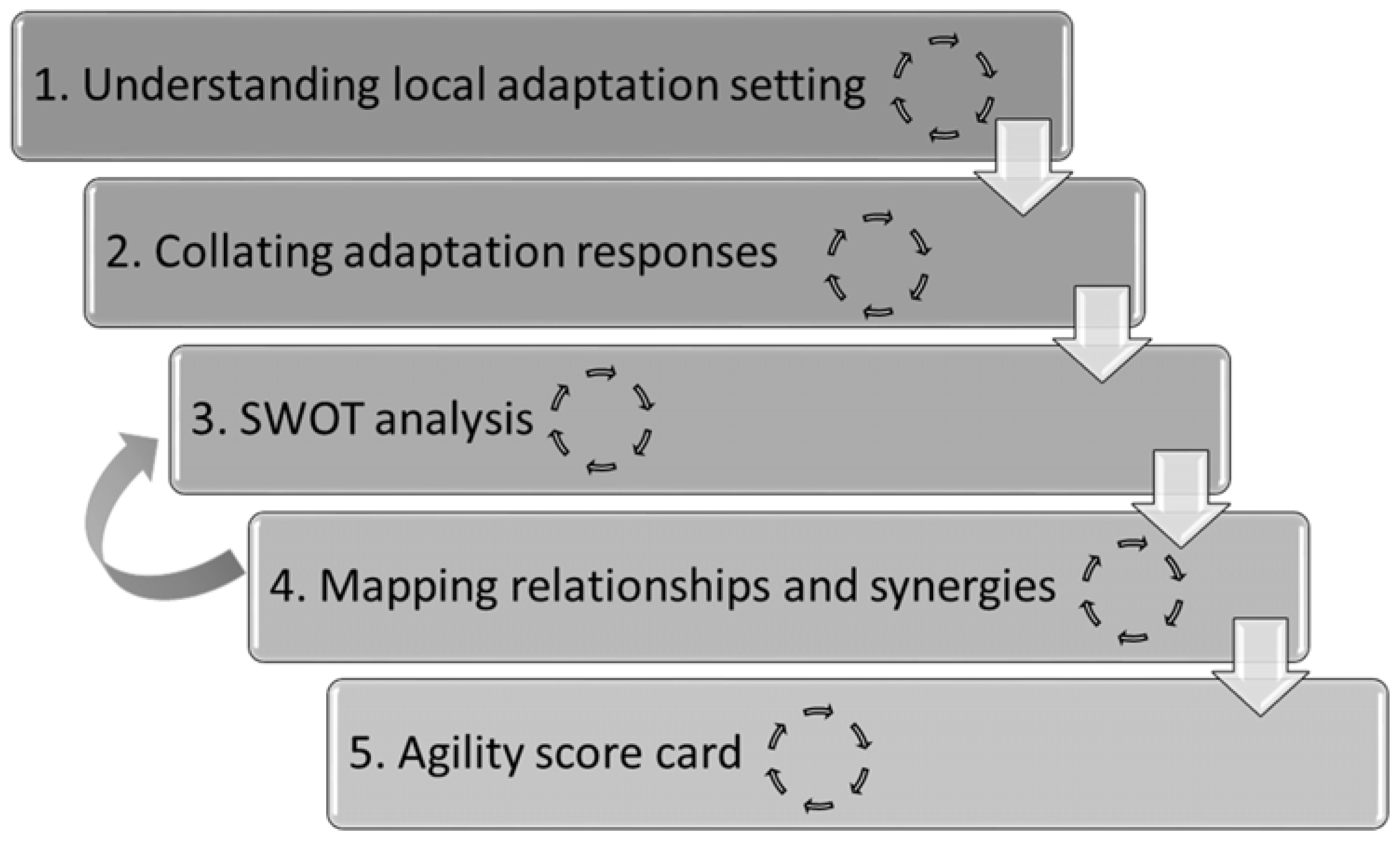

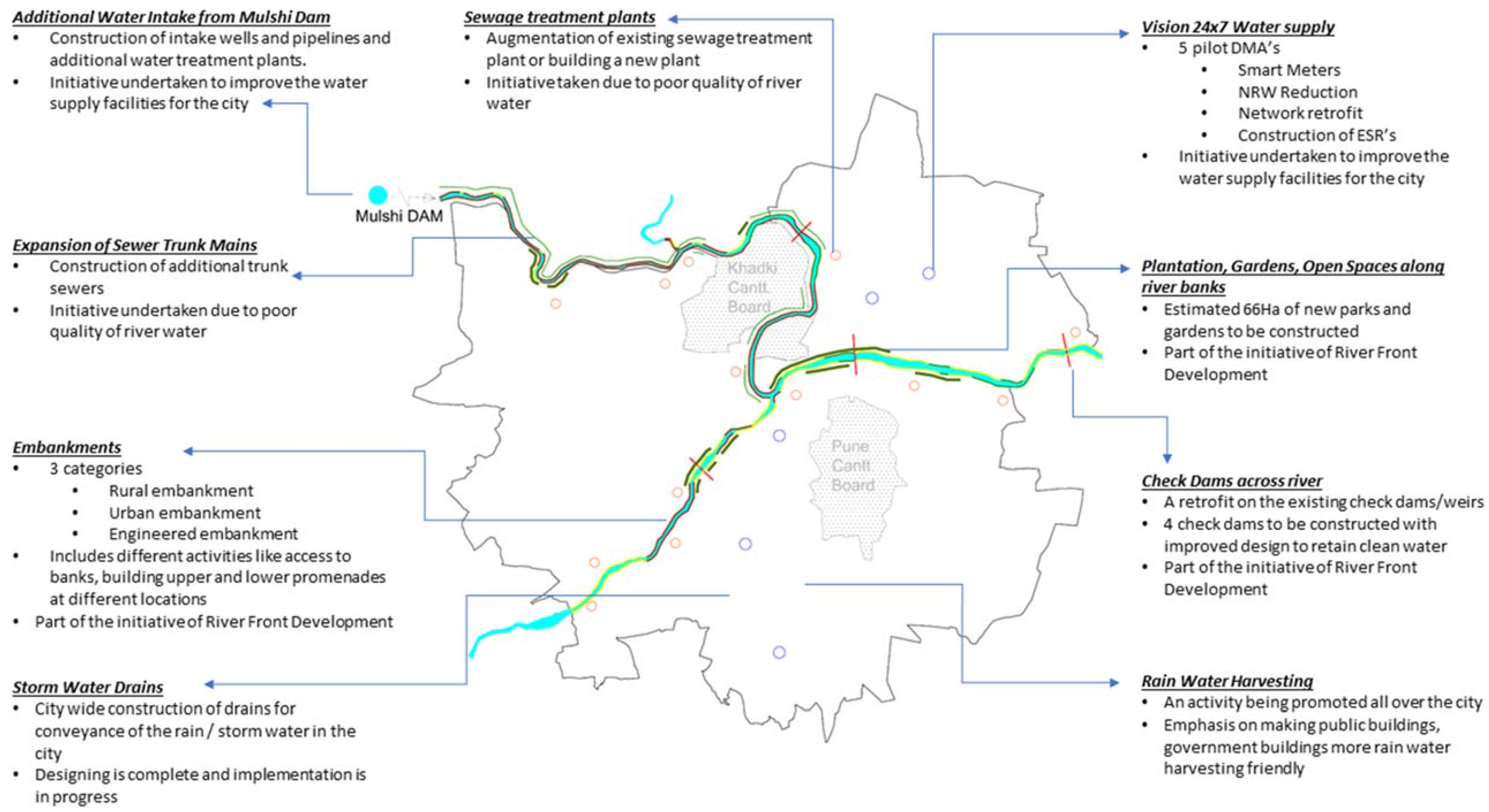
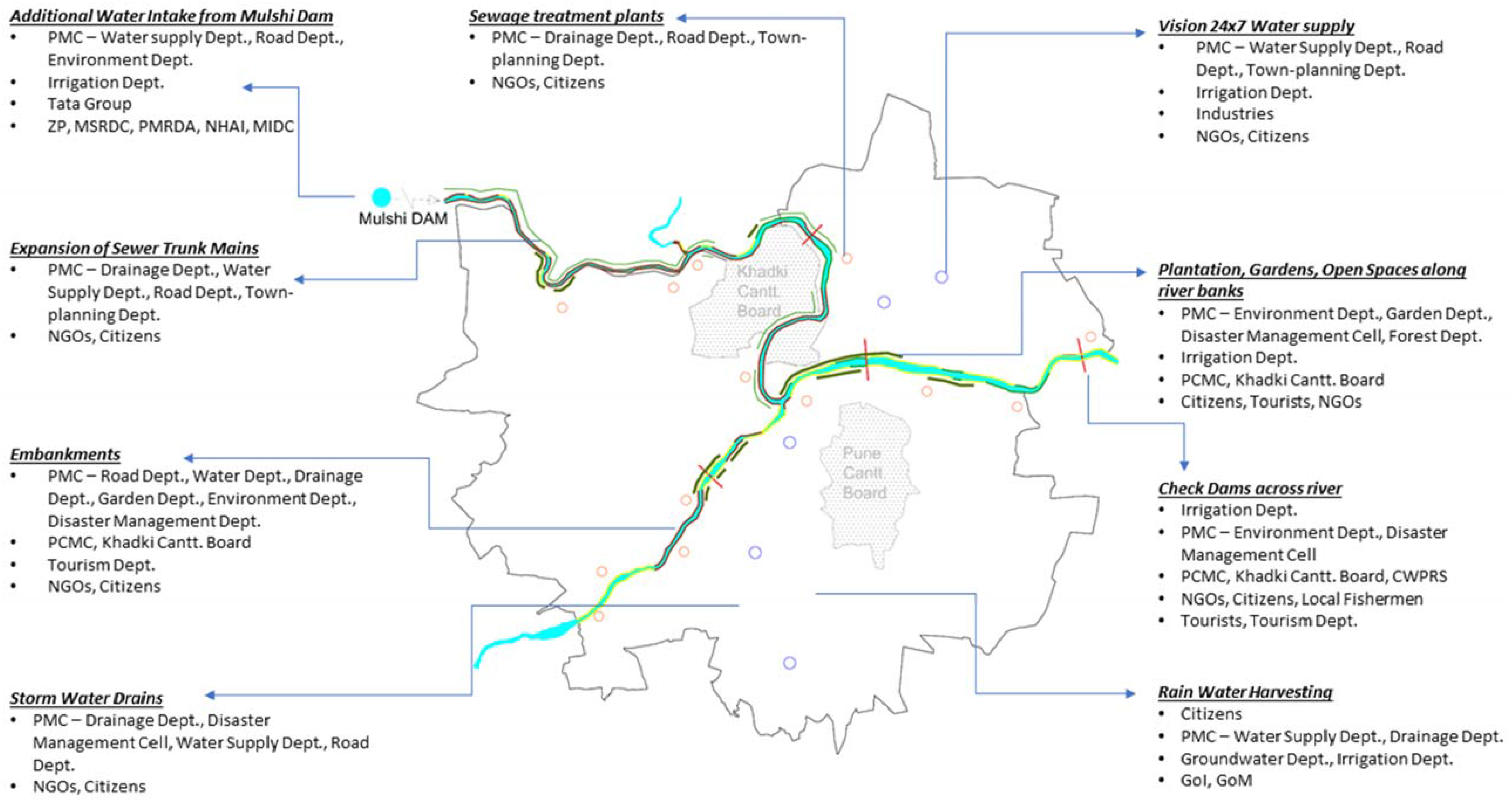
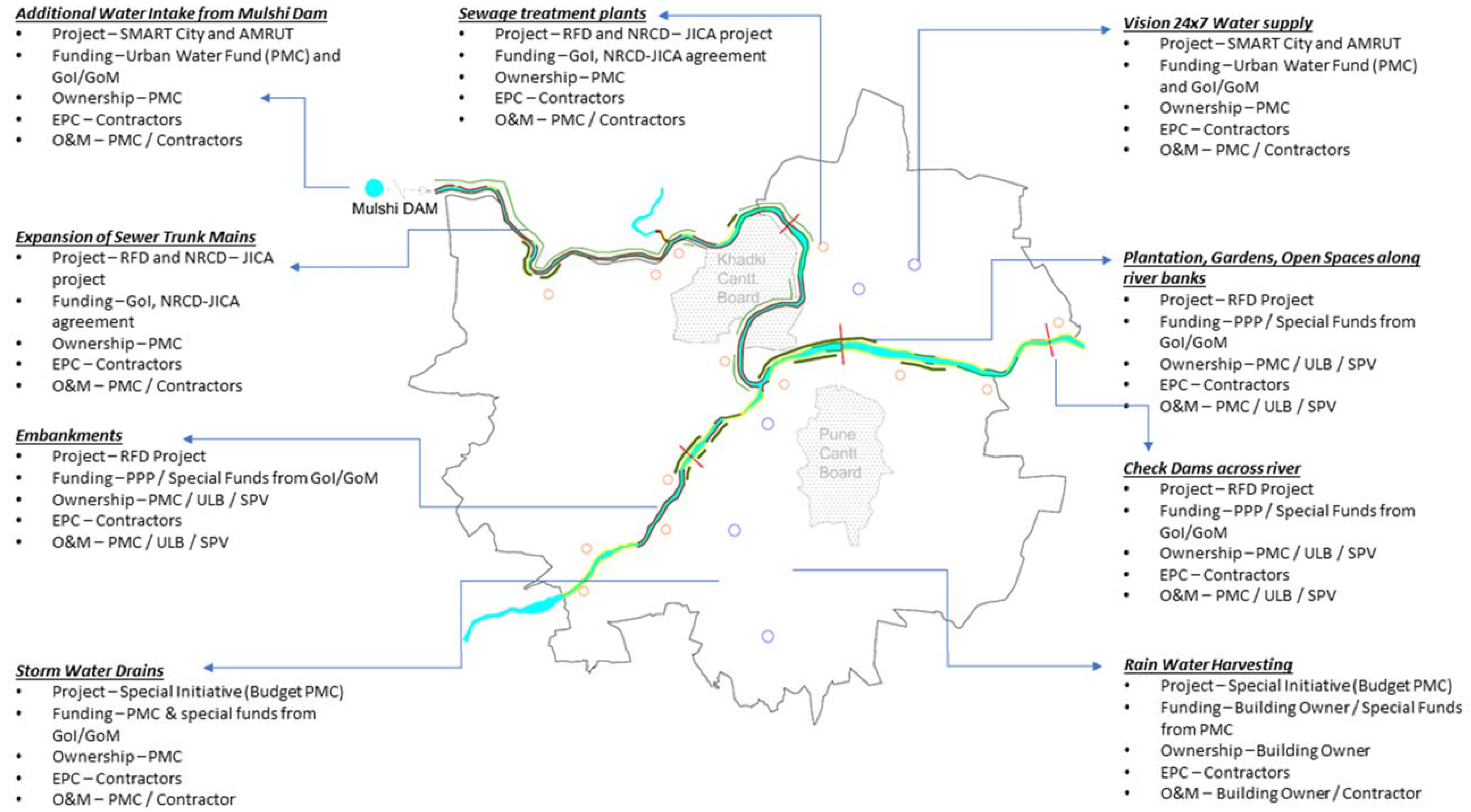
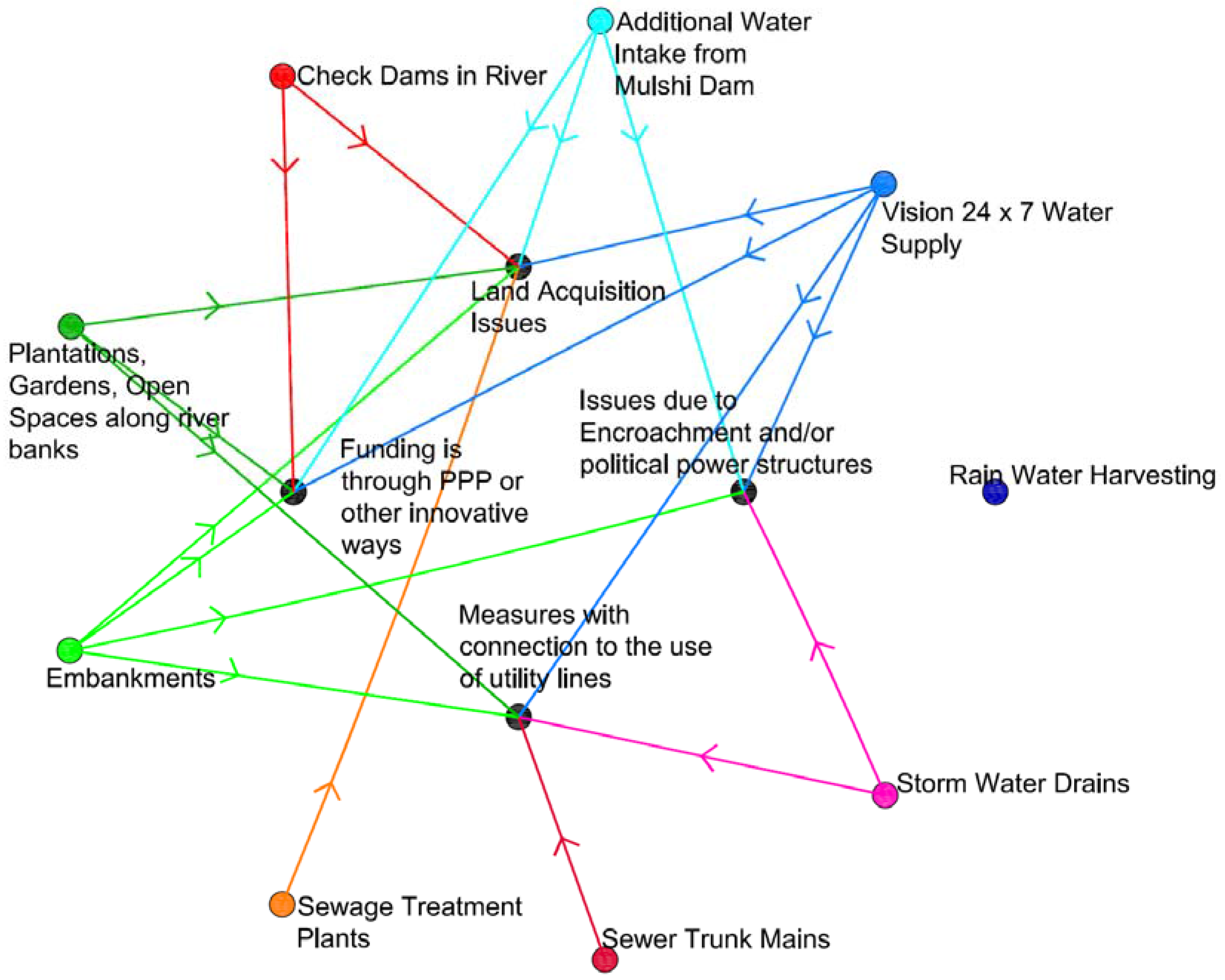
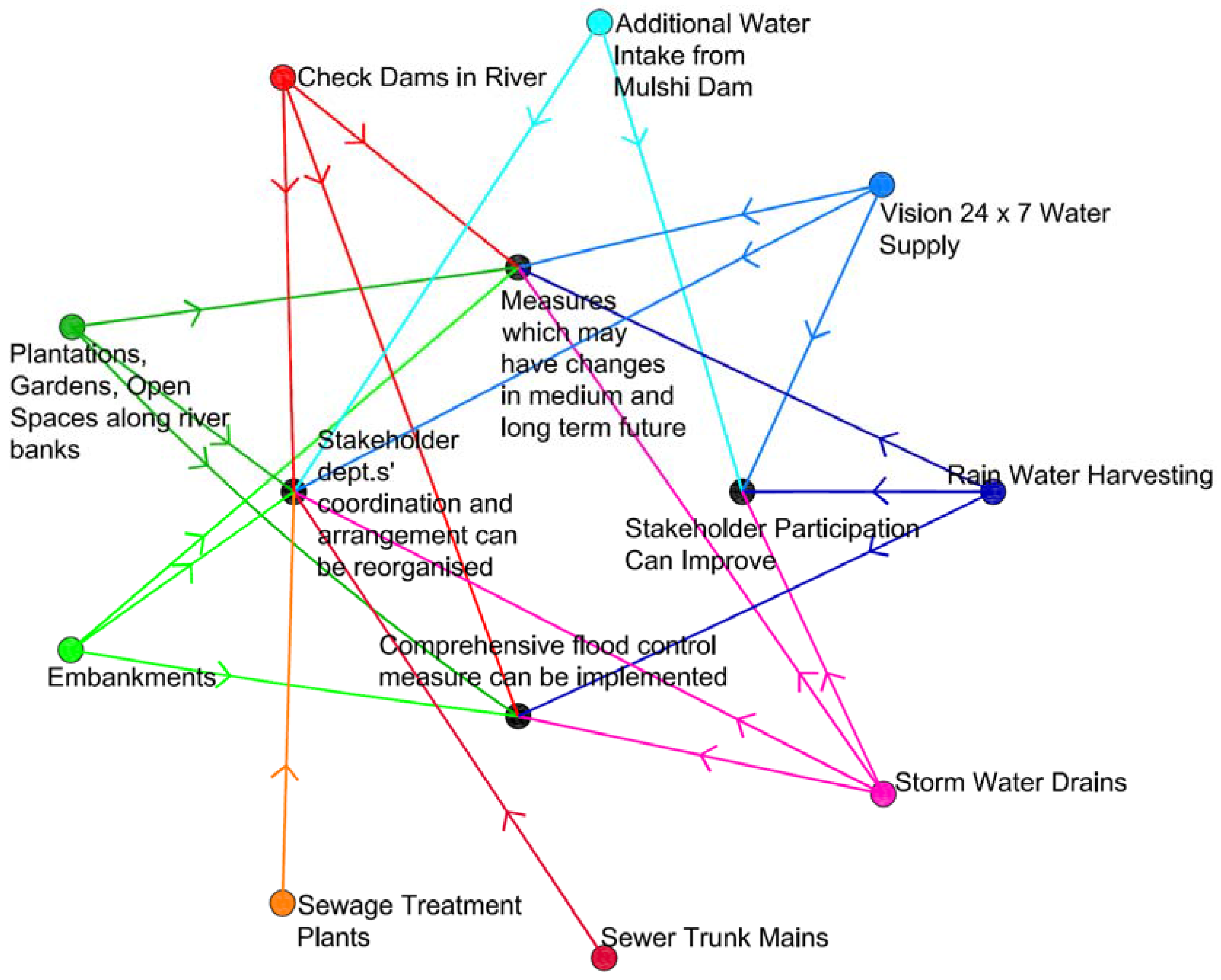
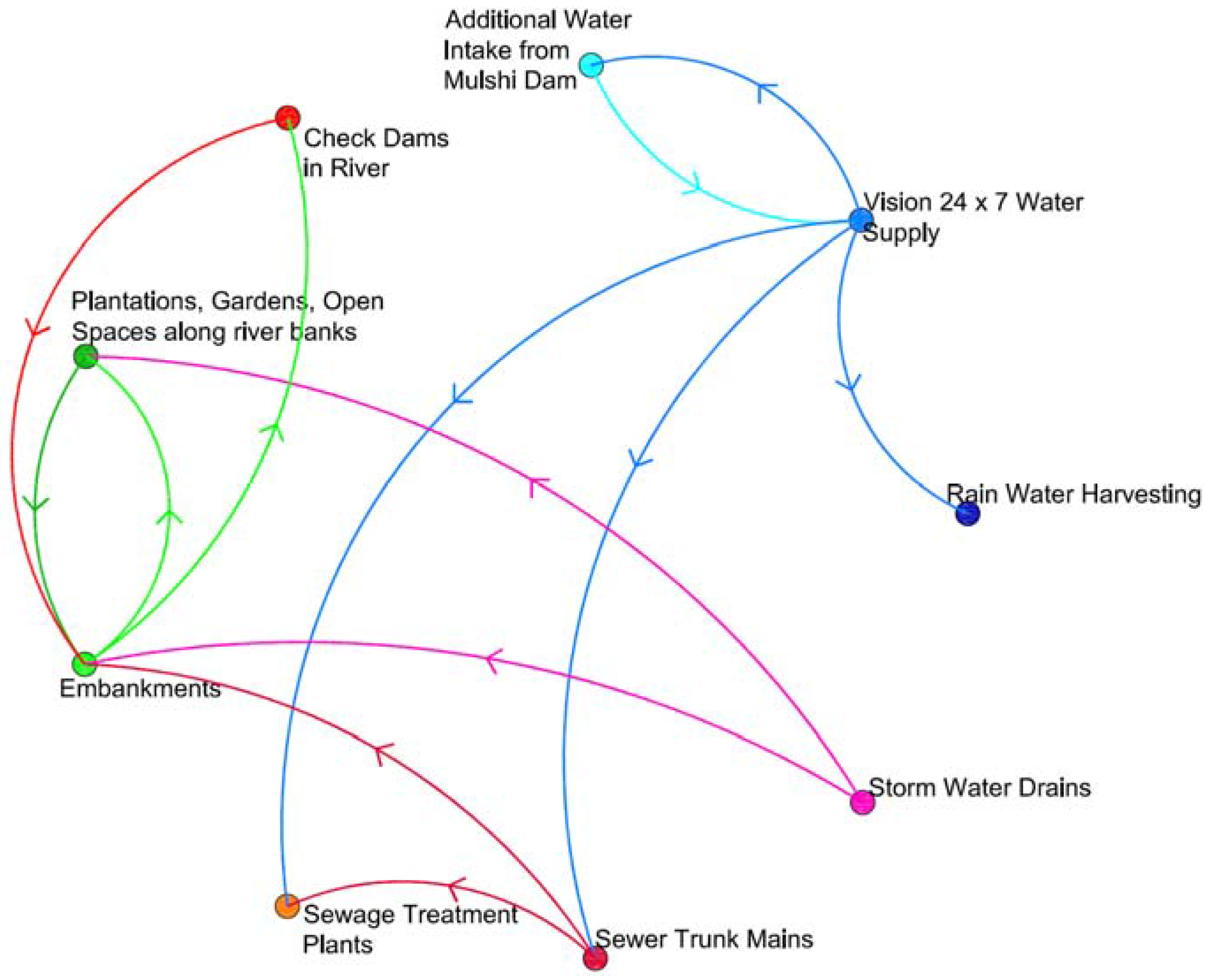
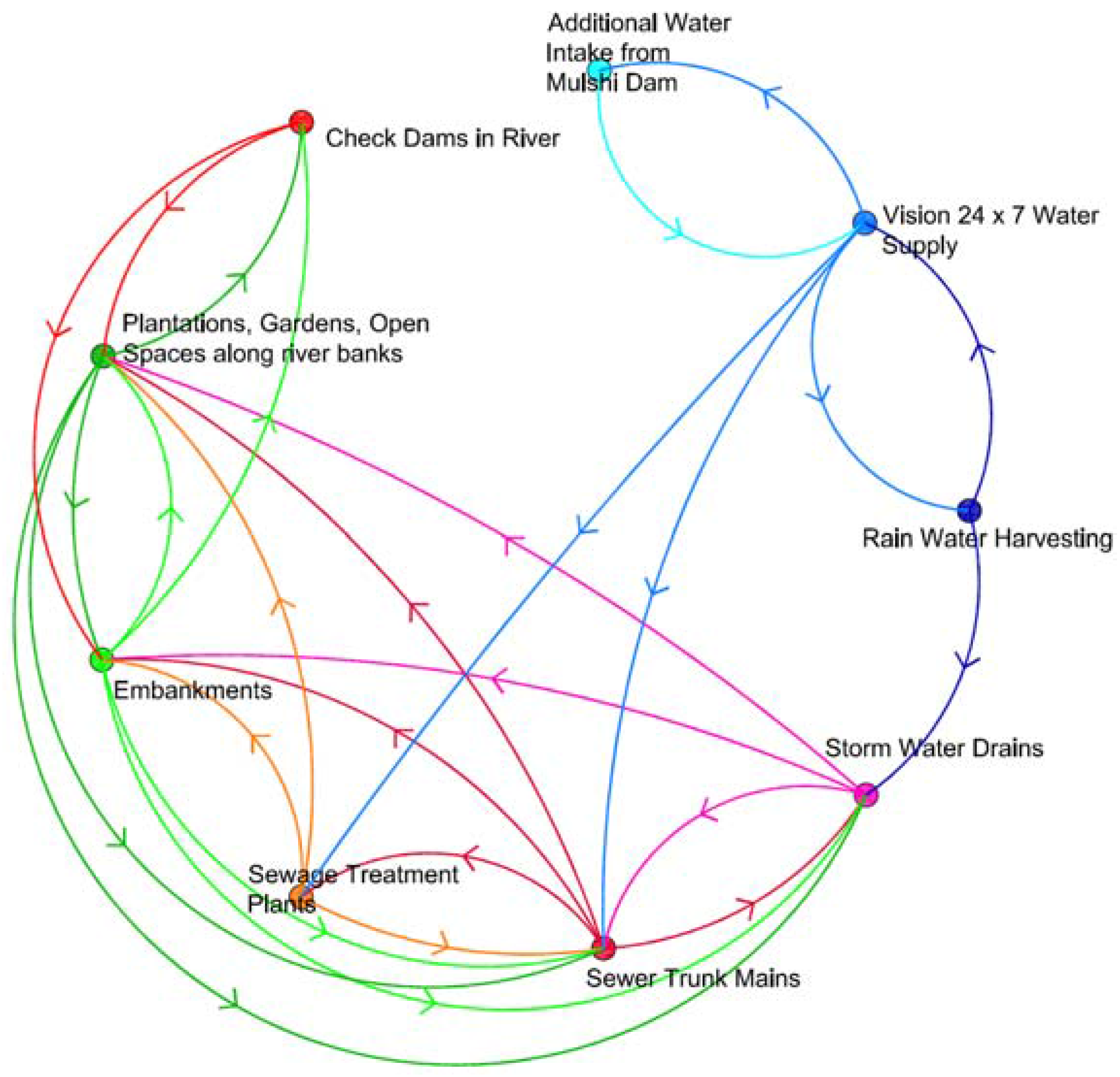
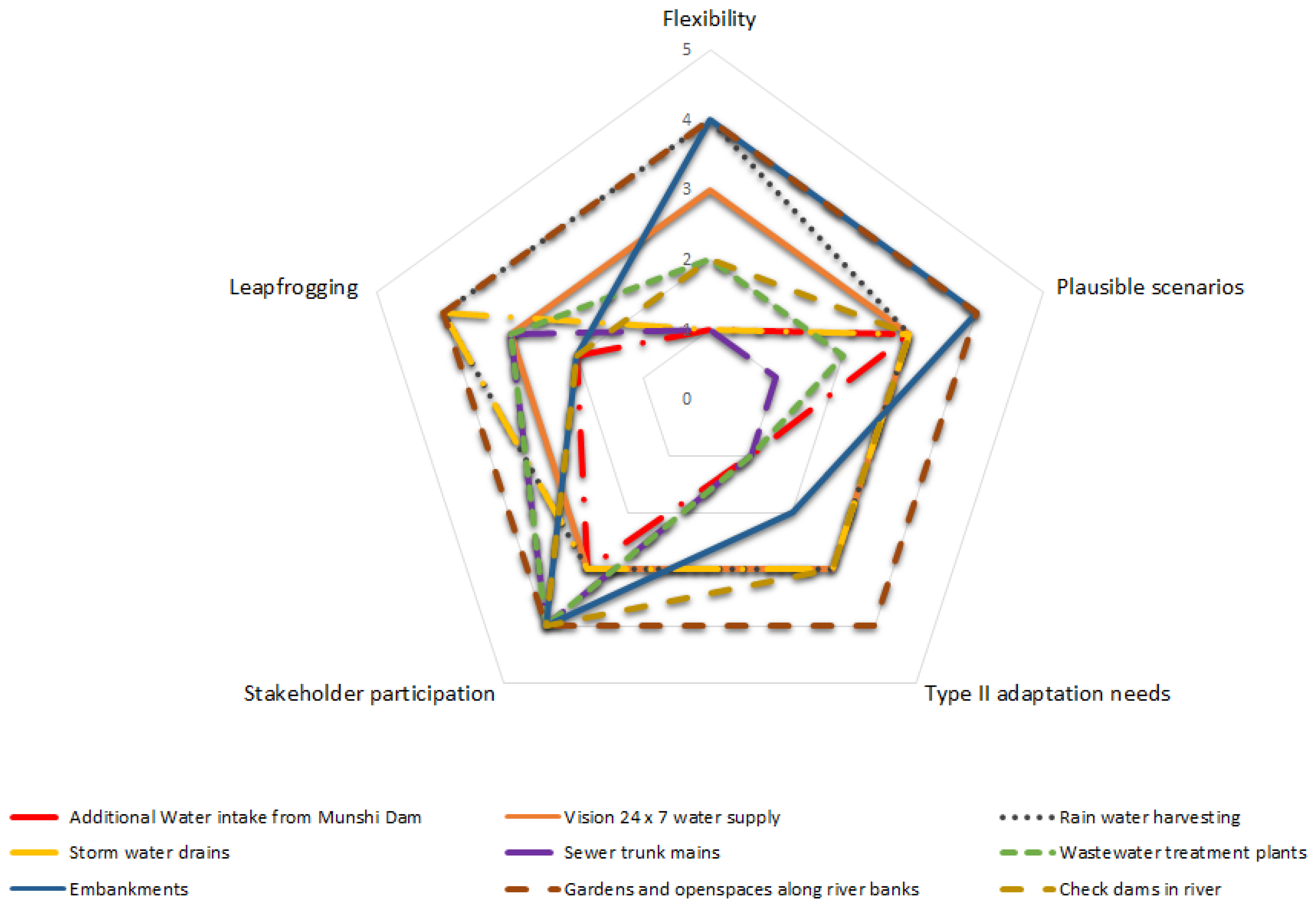
| AMRUT | Atal Mission for Rejuvenation and Urban Transformation |
|---|---|
| Cantt | Cantonment |
| CPCB | Central Pollution Control Board |
| CPHEEO | Central Public Health and Environmental Engineering Organisation |
| CWPRS | Central Water and Power Research Station |
| GoI | Government of India |
| GoM | Government of Maharashtra |
| IPCC | Intergovernmental Panel on Climate Change |
| JICA | Japan International Cooperation Agency |
| MIDC | Maharashtra Industrial Development Corporation |
| MoUD | Ministry of Urban Development |
| MSRDC | Maharashtra State Road Development Corporation |
| NGO | Non-Governmental Organisation |
| NHAI | National Highways Authority of India |
| NRCD | National River Conservation Directorate |
| PCMC | Pimpri Chinchwad Municipal Corporation |
| PMC | Pune Municipal Corporation |
| PMRDA | Pune Metropolitan Region Development Authority |
| RFD | River Front Development |
| ZP | Zilla Parishad (District Council) |
| Service Level Parameters for Indian Cities | Desired Service Level Benchmark | Current Service Levels of Pune * | Reference |
|---|---|---|---|
| Water Supply | |||
| Coverage of Water Supply connections | 100% | 90% | ESR [45] |
| Per Capita Supply of Water | 135 L/pers/day | 90–120 | Smart City Plan [46] |
| Extent of Non-Revenue Water | 15% | 30% | Smart City Plan [46] |
| Extent of Metering | 100% | 30% | ESR [45] |
| Continuity of Water supplied | 24 h/day | 5 h/day | ESR [45] |
| Efficiency in redressal of customer complaints | 80% | 100% | ESR [45] |
| Quality of Water Supplied | 100% | 100% | ESR [45] |
| Cost Recovery | 100% | 71% | City development plan [47] |
| Efficiency in Collection of Water Charges | 90% | 91% | ESR [45] |
| Solid Waste Management | |||
| Household Level Coverage | 100% | 60% | ESR [45] |
| Efficiency in Collection of Solid Waste | 100% | 100% | ESR [45] |
| Extent of Segregation of Solid Waste | 100% | 44% | ESR [45] |
| Extent of Solid Waste recovered | 80% | 80% | ESR [45] |
| Extent of Scientifically sound Disposal | 100% | 50% | ESR [45] |
| Extent of Cost Recovery | 100% | 80% | ESR [45] |
| Efficiency in Collection of SWM Charges | 90% | 80% | ESR [45] |
| Efficiency in Redressal of Customer Complaints | 80% | 91% | ESR [45] |
| Sewerage | |||
| Coverage of Toilets | 100% | 98% | ESR [45] |
| Coverage of Sewerage Network | 100% | 99% | ESR [45] |
| Collection efficiency of Sewerage Network | 100% | 80% | ESR [45] |
| Adequacy of Sewage Treatment Capacity | 100% | 76% | ESR [45] |
| Quality of Sewage Treatment | 100% | 100% | ESR [45] |
| Extent of Reuse and Recycling of Sewage | 20% | 8% | ESR [45] |
| Extent of cost recovery in waste water management | 100% | 90% | ESR [45] |
| Efficiency in redressal of customer complaints | 80% | 80% | ESR [45] |
| Efficiency in Collection of Sewage Water Charges | 90% | 80% | ESR [45] |
| Storm Water Drainage | |||
| Coverage | 100% | 55% | City development plan [47] |
| Incidence of water logging | 0 numbers | 52 Nos. | City development plan [47] |
| Additional Water Intake from Mulshi Dam | Sewage Treatment Plants | 24 × 7 Water Supply | |||
|---|---|---|---|---|---|
| Strength Assured water availability and water transport | Weakness Dependency on single source Too many competing stakeholders | Strength Improved river water quality | Weakness Land acquisition and public acceptance for facility in the vicinity | Strength Improved service levels | Weakness Lack of coordination between Planning and water department |
| Opportunity Possibilities to develop a regional water plan and secondary water sources Possibilities for institutional arrangements between stakeholders | Threat Failure will have cascading effect Land acquisition and implementation hurdles might lead to delay and cost escalations | Opportunity Possibilities to design and implement nature based treatment system using gardens, wet lands and open space | Threat High probability for plant to reach peak capacity before the end of design period | Opportunity Possibilities for institutional arrangements between stakeholders Possibilities to postpone water intake works | Threat Likely changes in population density and land use patterns |
| Expansion of Trunk Sewer | Check Dams in River | Gardens and Open spaces along the river | |||
| Strength Better public health and river water quality Guaranteed funds | Weakness Construction hurdles in densely populated areas | Strength Increased water availability, flood control and regulated silting | Weakness Land acquisition O&M difficulties | Strength Improved biodiversity, embankment strength and flood protection | Weakness Land acquisition O&M difficulties |
| Opportunity Mainstreaming with roads, electric cables, etc., Possibilities for stakeholder institutional arrangements | Threat Dumping of solid waste might lead to O&M difficulties High path dependency leading to future complications. | Opportunity Construction compatibility with embankments and recreation facilities | Threat Hindrance to navigation Lack of warning system, preparedness and operational protocol during cloudburst. | Opportunity Mainstreaming with transportation, recreation, urban farming and open space facilities | Threat Increased public access to riparian areas is a threat to ecosystems. |
| Embankments | Strom Water Drains | Rainwater harvesting | |||
| Strength Better access to river side leading to increase in public and tourist activity | Weakness Relocating existing infrastructure such as Dobhi ghats | Strength Reduced water logging, road accidents and health issues | Weakness Removal of encroachments and availability of funds | Strength Improved ground water levels | Weakness High dependency on proactive public participation |
| Opportunity Mainstreaming with roads, electric cables, gardens, etc., Possibilities for institutional arrangements between stakeholders | Threat Land acquisition issues leading to cost overruns and time delays | Opportunity Mainstreaming with roads, electric cables, gardens, etc., Possibilities for institutional arrangements between stakeholders | Threat Land acquisition issues leading to cost overruns and time delays | Opportunity Reduced dependence on city water supply Tax/water tariff incentives | Threat Lack of adequate maintenance and water quality issues. |
© 2017 by the authors. Licensee MDPI, Basel, Switzerland. This article is an open access article distributed under the terms and conditions of the Creative Commons Attribution (CC BY) license (http://creativecommons.org/licenses/by/4.0/).
Share and Cite
Radhakrishnan, M.; Pathak, T.M.; Irvine, K.; Pathirana, A. Scoping for the Operation of Agile Urban Adaptation for Secondary Cities of the Global South: Possibilities in Pune, India. Water 2017, 9, 939. https://doi.org/10.3390/w9120939
Radhakrishnan M, Pathak TM, Irvine K, Pathirana A. Scoping for the Operation of Agile Urban Adaptation for Secondary Cities of the Global South: Possibilities in Pune, India. Water. 2017; 9(12):939. https://doi.org/10.3390/w9120939
Chicago/Turabian StyleRadhakrishnan, Mohanasundar, Tejas M. Pathak, Kenneth Irvine, and Assela Pathirana. 2017. "Scoping for the Operation of Agile Urban Adaptation for Secondary Cities of the Global South: Possibilities in Pune, India" Water 9, no. 12: 939. https://doi.org/10.3390/w9120939





